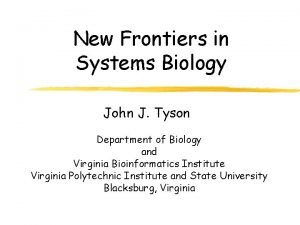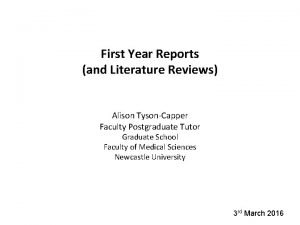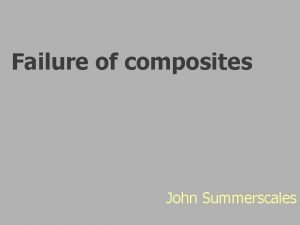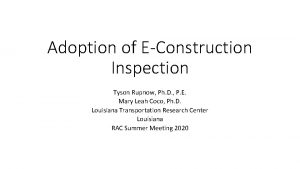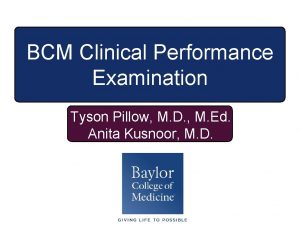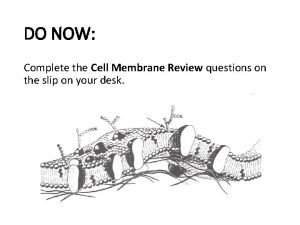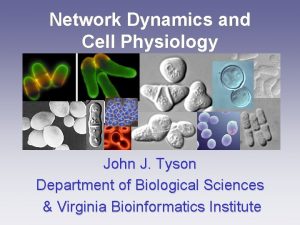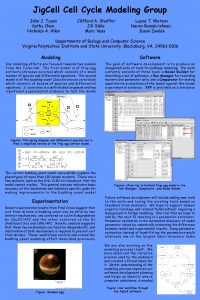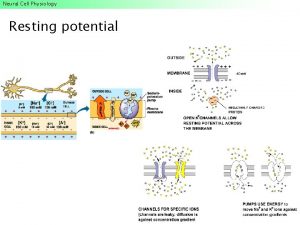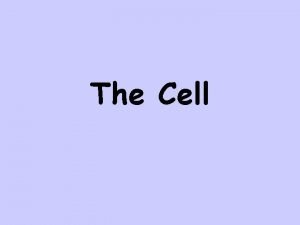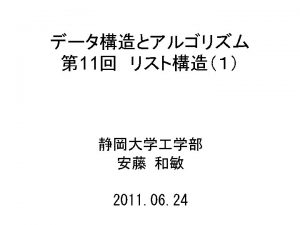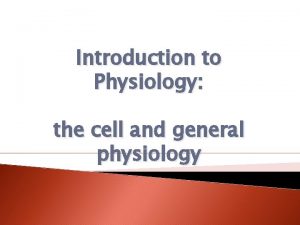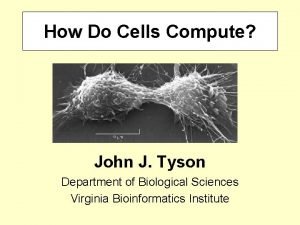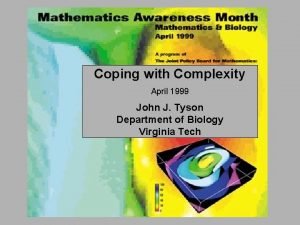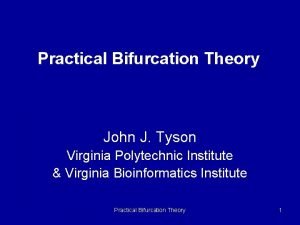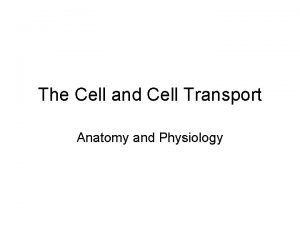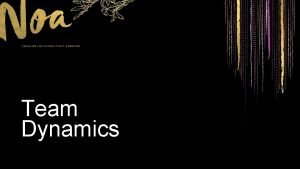Network Dynamics and Cell Physiology John J Tyson


































- Slides: 34

Network Dynamics and Cell Physiology John J. Tyson Dept. Biological Sciences Virginia Tech

Collaborators Budapest Univ. Techn. & Econ. Bela Novak Attila Csikasz-Nagy Andrea Ciliberto Virginia Tech Kathy Chen Dorjsuren Battogtokh Funding James S. Mc. Donnell Foundation DARPA

Computational Molecular Biology DNA …TACCCGATGGCGAAATGC. . . m. RNA …AUGGGCUACCGCUUUACG. . . Protein …Met -Gly -Tyr -Arg -Phe -Thr. . . Enzyme Reaction Network Cell Physiology -P ATP E 1 ADP X E 2 Y E 3 Z E 4 Last Step

G 1 cell division The cell cycle is the sequence of events whereby a growing cell replicates all its components and divides them more-or-less evenly between two daughter cells. . . M mitosis S DNA replication G 2

G 1 cell division S Cyclin-dependent kinase Cyclin B P M mitosis DNA replication Cdk 1 Cyc. B P G 2

P Wee 1 Cdc 20 Cdc 14 P TFBA Wee 1 Cyc. B Cdc 25 TFBI APC-P Cdc 14 0 P c 2 Cd Cyc. B Cdc 14 h 1 Cd Cdc 25 CKI Coupled Intra-cellular Cyc. B Networks ! Cyc. D Cyc. E TFII Cdh 1 TFIA CKI CKI Cyc. A Cyc. D Cyc. E Cyc. A Cyc E, A, B 0 c 2 Cd Cyc. E Cyc. A TFEA Cyc. B Cyc. D Cyc. A TFEI

Gene Expression linear rate (d. R/dt) S S=3 S=2 R S=1 response (R) rate of degradation rate of synthesis R signal (S) Signal-Response Curve

Protein Phosphorylation Kinase RP Pi response (RP) R ADP 1. 5 rate (d. RP/dt) ATP 2 1 0. 5 H 2 O 0. 25 Phosphatase RP 1 R Signal (Kinase) 0 “Buzzer” Goldbeter & Koshland, 1981

Protein Synthesis: Positive Feedback S=16 S=8 rate (d. R/dt) R EP S=0 Closed E R Bistability Griffith, 1968 Open response (R) S signal (S) “Fuse”

response (R) Example: Fuse dying living signal (S) Apoptosis (Programmed Cell Death)

S rate (d. R/dt) S=1. 8 R S=1. 2 response (R) Protein Degradation: Mutual Inhibition SN SN S=0. 6 EP E R Bistability signal (S) “Toggle”

Positive Feedback & Substrate Depletion Hopf response (R) Hopf S substrate X R R EP E sss positive X Oscillation Higgins, 1965; Selkov, 1968 uss signal (S) “Blinker” Glycolytic Oscillations

S response (RP) Negative Feedback Loop YP X X Y Hopf YP R RP RP time Goodwin, 1965 signal (S)

Example: Bacterial Chemotaxis Barkai & Leibler, 1997 Goldbeter & Segel, 1986 Bray, Bourret & Simon, 1993

Sniffer X S rate (d. R/dt) S=3 R S X S=2 S=1 R R Response is independent of Signal time (Levchenko & Iglesias, 2002)

Example 2: Cell Cycle high SPF high MPF primed MEN fired RC Cdk 2 Cdk 1 Cyc. A Cyc. B primed RC low SPF fired MEN low MPF (Csikasz-Nagy & Novak, 2005)

Cock-and-Fire LA Signal = CDK Cdk 2 Cyc. A + LA F Response = F L

Cock-and-Fire-2 Signal = MPF TA T Cdk 1 + Cyc. B B TA + BA Response = BA

P Wee 1 Cdc 20 Cdc 14 P Wee 1 Cyc. B bistable switch TFBA Cdc 25 TFBI oscillator APC-P Cdc 14 0 P c 2 Cd Cyc. B Cdc 14 h 1 Cd CKI Cdc 25 Cyc. D Cyc. B bistable switch Cyc. E TFII Cdh 1 TFIA CKI CKI Cyc. A Cyc. D Cyc. E Cyc. A Cyc E, A, B bistable switch 0 c 2 Cd Cyc. E Cyc. A TFEA Cyc. B Cyc. D Cyc. A TFEI oscillator

P Wee 1 mass/nucleus Cdc 14 TFBA M Wee 1 Cyc. B S/G 2 Cdc 25 TFBI M APC-P Cdc 14 0 P c 2 Cd Cyc. B Cdc 14 h 1 Cd CKI Cdc 25 M Cyc. D Cyc. B Cyc. E TFII Cdh 1 TFIA CKI Cyc. A Cyc. D CKI P Cdc 20 Cyc. E G 1 Cyc. A Cyc E, A, B 0 c 2 Cd Cyc. E TFEA Fission Yeast Cyc. B Cyc. D Cyc. A TFEI Cyc. A

3. 0 Wild type M Cdk 1: Cyc. B 0. 8 0. 4 S/G 2 G 1 0 SNIPER 0 1 2 3 mass/nucleus 4 5

Nature, Vol, 256, No. 5518, pp. 547 -551, August 14, 1975 Genetic control of cell size at cell division in yeast Paul Nurse Department of Zoology, West Mains Road, Edinburgh EH 9 3 JT, UK wild-type wee 1

P Wee 1 Cdc 20 Cdc 14 Wee 1 Cyc. B Cdc 25 TFBI APC-P Cdc 14 0 P c 2 Cd Cyc. B Cdc 14 h 1 Cd CKI Cdc 25 Cyc. D Cyc. B Cyc. E TFII Cdh 1 TFIA CKI Cyc. A Cyc. D CKI P TFBA Cyc. E Cyc. A Cyc E, A, B 0 c 2 Cd Cyc. E Cyc. A TFEA Cyc. B Cyc. D Cyc. A TFEI

wee 1 cells are about one-half the size of wild type 1. 2 wee 1 Cdk 1: Cyc. B M 0. 8 0. 4 S/G 2 0 G 1 0 1 2 3 mass/nucleus 4 5

Two-parameter Bifurcation Diagram Wee 1 activity GENETICS SNIPER wild-type wee 1 - cell mass (au. ) PHYSIOLOGY 0 30 60 90 120 150 180 210 240 270 300 period (min) 0 50 100 150 200 250 300 350 400 450 500 550

P Wee 1 Cdc 20 Cdc 14 Wee 1 Cyc. B Cdc 25 TFBI APC-P Cdc 14 0 P c 2 Cd Cyc. B Cdc 14 h 1 Cd CKI Cdc 25 Cyc. D Cyc. B Cyc. E TFII Cdh 1 TFIA CKI Cyc. A Cyc. D CKI P TFBA Cyc. E Cyc. A Cyc E, A, B 0 c 2 Cd Cyc. E Cyc. A TFEA Cyc. B Cyc. D Cyc. A TFEI

The Start module is not required during mitotic cycles 3. 0 cki M Cdk 1: Cyc. B 0. 8 0. 4 S/G 2 G 1 0 0 1 2 3 mass/nucleus 4 5

P Wee 1 Cdc 20 Cdc 14 Wee 1 Cyc. B Cdc 25 TFBI APC-P Cdc 14 0 P c 2 Cd Cyc. B Cdc 14 h 1 Cd CKI Cdc 25 Cyc. D Cyc. B Cyc. E TFII Cdh 1 TFIA CKI Cyc. A Cyc. D CKI P TFBA Cyc. E Cyc. A Cyc E, A, B 0 c 2 Cd Cyc. E Cyc. A TFEA Cyc. B Cyc. D Cyc. A TFEI

Cells become progressively smaller without size control cki wee 1 ts 1 st Cdk 1: Cyc. B 2. 0 0. 8 2 nd M 3 rd 4 th 0. 4 S/G 2 0 G 1 0 1 2 3 mass/nucleus 4 5

P Wee 1 Cdc 20 Cdc 14 Wee 1 Cyc. B Cdc 25 TFBI APC-P Cdc 14 0 P c 2 Cd Cyc. B Cdc 14 h 1 Cd CKI Cdc 25 Cyc. D Cyc. B Cyc. E TFII Cdh 1 TFIA CKI Cyc. A Cyc. D CKI P TFBA Cyc. E Cyc. A Cyc E, A, B 0 c 2 Cd Cyc. E Cyc. A TFEA Cyc. B Cyc. D Cyc. A TFEI

Fission yeast S Act Cyc. A cdc 13 D endoreplication G 2 G 1 mitotic cycle M No production of cyclin B (Cdc 13) 2 param bifn diag for Cdc 13 Production of Cdc 13 X Wild type mitotic cycles ? ? endoreplication mass cdc 13 +/D cdc 13 D

The Dynamical Perspective Molecular Mechanism ? ? ? Physiological Properties

The Dynamical Perspective Molecular Mechanism Kinetic Equations Vector Field Stable Attractors Physiological Properties

References • Tyson, Chen & Novak, “Network dynamics and cell physiology, ” Nature Rev. Molec. Cell Biol. 2: 908 (2001). • Tyson, Csikasz-Nagy & Novak, “The dynamics of cell cycle regulation, ” Bio. Essays 24: 1095 (2002). • Tyson, Chen & Novak, “Sniffers, buzzers, toggles and blinkers, ” Curr. Opin. Cell Biol. 15: 221 (2003).
 John j. tyson
John j. tyson John j. tyson
John j. tyson Tyson foods mission and vision statement
Tyson foods mission and vision statement Alison tyson xxx
Alison tyson xxx Kelly tyson
Kelly tyson Tyson conway
Tyson conway Unit 1 digital literacy
Unit 1 digital literacy Tyson rupnow
Tyson rupnow Clinical performance examination
Clinical performance examination Rachel tyson
Rachel tyson Cell physiology membrane transport
Cell physiology membrane transport Cell physiology membrane transport worksheet
Cell physiology membrane transport worksheet Difference between mercury cell and diaphragm cell
Difference between mercury cell and diaphragm cell Prokaryotic and eukaryotic cells
Prokaryotic and eukaryotic cells Venn diagram plant and animal cell
Venn diagram plant and animal cell Plant cell and animal cell diagram
Plant cell and animal cell diagram Plant cell and animal cell
Plant cell and animal cell Types of secondary cells
Types of secondary cells Difference between plant and animal cell
Difference between plant and animal cell Events of the cell cycle
Events of the cell cycle Prokaryotic cell and eukaryotic cell
Prokaryotic cell and eukaryotic cell Chapter 4 cell theory and cell study
Chapter 4 cell theory and cell study Idealized animal cell
Idealized animal cell Walker cell and hadley cell
Walker cell and hadley cell Cell cycle and cell division
Cell cycle and cell division Animal cell venn diagram
Animal cell venn diagram Cell division phases
Cell division phases Voltaic vs electrolytic cell
Voltaic vs electrolytic cell Rigid outer covering of plant cells
Rigid outer covering of plant cells Datagram switching and virtual circuit switching
Datagram switching and virtual circuit switching Features of peer to peer network and client server network
Features of peer to peer network and client server network Network centric computing
Network centric computing Cell city worksheet
Cell city worksheet Site:slidetodoc.com
Site:slidetodoc.com Zn cu
Zn cu

